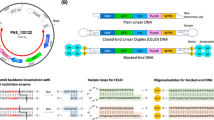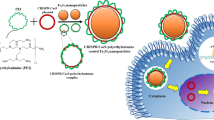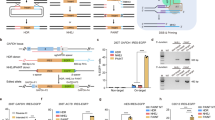Abstract
A major issue for successful human gene therapy or genetic vaccination is a safe high-transgene expression level. Plasmid-based (non-viral) physical methods of gene transfer offered attracting approaches but their low efficiencies have limited their use in human pre-clinical trials. One of the limits appears to be the size of the plasmid that must be transferred across the cell membrane to the nucleus for its processing. In the present work to enhance gene transfer and expression, we evaluated a new generation of DNA vector; the minicircle, combined with the electropulsation technique. Minicircle is a doubled-stranded circular DNA with reduced size as it is devoid of bacterial sequences. We showed that electrotransferred minicircle encoding green fluorescent protein had higher in vitro transfection level compared with full-length plasmid. We demonstrated that minicircle great efficiency was not because of cellular toxicity decrease but was correlated to more efficient vector uptake by cells. Vector electrotransfection was operated in vivo and, using fluorescence imaging, minicircle electrotransfer was shown to enhance the efficiency and duration of tissue-targeted gene delivery and expression. By combining powerful expression and delivery systems, we have provided a valuable method for new approaches in gene therapy and genetic vaccination.
This is a preview of subscription content, access via your institution
Access options
Subscribe to this journal
Receive 12 print issues and online access
$259.00 per year
only $21.58 per issue
Buy this article
- Purchase on Springer Link
- Instant access to full article PDF
Prices may be subject to local taxes which are calculated during checkout




Similar content being viewed by others
References
Herweijer H, Wolff JA . Progress and prospects: naked DNA gene transfer and therapy. Gene Therapy 2003; 10: 453–458.
Darquet AM, Cameron B, Wils P, Scherman D, Crouzet J . A new DNA vehicle for nonviral gene delivery: supercoiled minicircle. Gene Therapy 1997; 4: 1341–1349.
Darquet AM, Rangara R, Kreiss P, Schwartz B, Naimi S, Delaere P et al. Minicircle: an improved DNA molecule for in vitro and in vivo gene transfer. Gene Therapy 1999; 6: 209–218.
Chen ZY, He CY, Ehrhardt A, Kay MA . Minicircle DNA vectors devoid of bacterial DNA result in persistent and high-level transgene expression in vivo. Mol Ther 2003; 8: 495–500.
Zhang X, Epperly MW, Kay MA, Chen ZY, Dixon T, Franicola D et al. Radioprotection in vitro and in vivo by minicircle plasmid carrying the human manganese superoxide dismutase transgene. Hum Gene Ther 2008; 19: 820–826.
Chang CW, Christensen LV, Lee M, Kim SW . Efficient expression of vascular endothelial growth factor using minicircle DNA for angiogenic gene therapy. J Control Release 2008; 125: 155–163.
Park JH, Lee M, Kim SW . Non-viral adiponectin gene therapy into obese type 2 diabetic mice ameliorates insulin resistance. J Control Release 2006; 114: 118–125.
Osborn MJ, McElmurry RT, Lees CJ, Defeo AP, Chen ZY, Kay MA et al. Minicircle DNA-based gene therapy coupled with immune modulation permits long-term expression of alpha-L-iduronidase in mice with mucopolysaccharidosis Type I. Mol Ther 2011; 19: 450–460.
Mayrhofer P, Blaesen M, Schleef M, Jechlinger W . Minicircle-DNA production by site specific recombination and protein-DNA interaction chromatography. J Gene Med 2008; 10: 1253–1269.
Cemazar M, Golzio M, Escoffre JM, Couderc B, Sersa G, Teissie J . In vivo imaging of tumor growth after electrochemotherapy with cisplatin. Biochem Biophys Res Commun 2006; 348: 997–1002.
Agerholm-Larsen B, Iversen HK, Ibsen P, Moller JM, Mahmood F, Jensen KS et al. Preclinical validation of electrochemotherapy as an effective treatment for brain tumors. Cancer Res 2011; 71: 3753–3762.
Cemazar M, Golzio M, Sersa G, Hojman P, Kranjc S, Mesojednik S et al. Control by pulse parameters of DNA electrotransfer into solid tumors in mice. Gene Therapy 2009; 16: 635–644.
Ferraro B, Heller LC, Cruz YL, Guo S, Donate A, Heller R . Evaluation of delivery conditions for cutaneous plasmid electrotransfer using a multielectrode array. Gene Therapy 2011; 18: 496–500.
Golzio M, Mazzolini L, Paganin-Gioanni A, Teissie J . Targeted gene silencing into solid tumors with electrically mediated siRNA delivery. Methods Mol Biol 2009; 555: 15–27.
Matsuda T, Cepko CL . Electroporation and RNA interference in the rodent retina in vivo and in vitro. Proc Natl Acad Sci USA 2004; 101: 16–22.
Schmeer M, Seipp T, Pliquett U, Kakorin S, Neumann E . Mechanism for the conductivity changes caused by membrane electroporation of CHO cell-pellets. PCCP 2004; 6: 5564–5574.
Mir LM, Glass LF, Sersa G, Teissie J, Domenge C, Miklavcic D et al. Effective treatment of cutaneous and subcutaneous malignant tumours by electrochemotherapy. Br J Cancer 1998; 77: 2336–2342.
Sersa G, Stabuc B, Cemazar M, Miklavcic D, Rudolf Z . Electrochemotherapy with cisplatin: the systemic antitumour effectiveness of cisplatin can be potentiated locally by the application of electric pulses in the treatment of malignant melanoma skin metastases. Melanoma Res 2000; 10: 381–385.
Gothelf A, Mir LM, Gehl J . Electrochemotherapy: results of cancer treatment using enhanced delivery of bleomycin by electroporation. Cancer Treat Rev 2003; 29: 371–387.
Sersa G, Miklavcic D, Cemazar M, Rudolf Z, Pucihar G, Snoj M . Electrochemotherapy in treatment of tumours. Eur J Surg Oncol 2008; 34: 232–240.
Daud AI, DeConti RC, Andrews S, Urbas P, Riker AI, Sondak VK et al. Phase I trial of interleukin-12 plasmid electroporation in patients with metastatic melanoma. J Clin Oncol 2008; 26: 5896–5903.
Pedron-Mazoyer S, Plouet J, Hellaudais L, Teissie J, Golzio M . New anti angiogenesis developments through electro-immunization: optimization by in vivo optical imaging of intradermal electro gene transfer. Biochim Biophys Acta 2007; 1770: 137–142.
Widera G, Austin M, Rabussay D, Goldbeck C, Barnett SW, Chen M et al. Increased DNA vaccine delivery and immunogenicity by electroporation in vivo. J Immunol 2000; 164: 4635–4640.
Olmachov OE . Tightly-wound miniknot vectors for gene therapy: a potential improvement over supercoiled minicircle DNA. Med Hypotheses 2010; 74: 702–704.
Bloquel C, Fabre E, Bureau MF, Scherman D . Plasmid DNA electrotransfer for intracellular and secreted proteins expression: new methodological developments and applications. J Gene Med 2004; 6 Suppl 1: S11–23.
Schakowski F, Gorschluter M, Junghans C, Schroff M, Buttgereit P, Ziske C et al. A novel minimal-size vector (MIDGE) improves transgene expression in colon carcinoma cells and avoids transfection of undesired DNA. Mol Ther 2001; 3: 793–800.
Wang XD, Tang JG, Xie XL, Yang JC, Li S, Ji JG et al. A comprehensive study of optimal conditions for naked plasmid DNA transfer into skeletal muscle by electroporation. J Gene Med 2005; 7: 1235–1245.
Li LH, Sen A, Murphy SP, Jahreis GP, Fuji H, Hui SW . Apoptosis induced by DNA uptake limits transfection efficiency. Exp Cell Res 1999; 253: 541–550.
Faurie C, Phez E, Golzio M, Vossen C, Lesbordes JC, Delteil C et al. Effect of electric field vectoriality on electrically mediated gene delivery in mammalian cells. Biochim Biophys Acta 2004; 1665: 92–100.
Golzio M, Teissie J, Rols MP . Direct visualization at the single-cell level of electrically mediated gene delivery. Proc Natl Acad Sci U S A 2002; 99: 1292–1297.
Golzio M, Rols MP, Gabriel B, Teissie J . Optical imaging of in vivo gene expression: a critical assessment of the methodology and associated technologies. Gene Therapy 2004; 11 Suppl 1: S85–S91.
Faurie C, Golzio M, Moller P, Teissie J, Rols MP . Cell and animal imaging of electrically mediated gene transfer. DNA Cell Biol 2003; 22: 777–783.
Gill DR, Pringle IA, Hyde SC . Progress and prospects: the design and production of plasmid vectors. Gene Therapy 2009; 16: 165–171.
Escoffre JM, Portet T, Favard C, Teissié J, Dean DS, Rols MP . Electromediated formation of DNA complexes with cell membranes and its consequences for gene delivery. Biochim Biophys Acta 2011; 1808: 1538–1543.
Zabner J, Fasbender AJ, Moninger T, Poellinger KA, Welsh MJ . Cellular and molecular barriers to gene transfer by a cationic lipid. J Biol Chem 1995; 270: 18997–19007.
Hartikka J, Sawdey M, Cornefert-Jensen F, Margalith M, Barnhart K, Nolasco M et al. An improved plasmid DNA expression vector for direct injection into skeletal muscle. Hum Gene Ther 1996; 7: 1205–1217.
Yew NS, Zhao H, Przybylska M, Wu IH, Tousignant JD, Scheule RK et al. CpG-depleted plasmid DNA vectors with enhanced safety and long-term gene expression in vivo. Mol Ther 2002; 5: 731–738.
Kako K, Nishikawa M, Yoshida H, Takakura Y . Effects of inflammatory response on in vivo transgene expression by plasmid DNA in mice. J Pharm Sci 2008; 97: 3074–3083.
Hodges BL, Taylor KM, Joseph MF, Bourgeois SA, Scheule RK . Long-term transgene expression from plasmid DNA gene therapy vectors is negatively affected by CpG dinucleotides. Mol Ther 2004; 10: 269–278.
Kosovac D, Wild J, Ludwig C, Meissner S, Bauer AP, Wagner R . Minimal doses of a sequence-optimized transgene mediate high-level and long-term EPO expression in vivo: challenging CpG-free gene design. Gene Therapy 2011; 18: 189–198.
Bauer AP, Leikam D, Krinner S, Notka F, Ludwig C, Langst G et al. The impact of intragenic CpG content on gene expression. Nucleic Acids Res 2010; 38: 3891–3908.
Trollet C, Bloquel C, Scherman D, Bigey P . Electrotransfer into skeletal muscle for protein expression. Curr Gene Ther 2006; 6: 561–578.
Bodles-Brakhop AM, Heller R, Draghia-Akli R . Electroporation for the delivery of DNA-based vaccines and immunotherapeutics: current clinical developments. Mol Ther 2009; 17: 585–592.
Mayrhofer P, Schleef M, Jechlinger W . Use of minicircle plasmids for gene therapy. Methods Mol Biol 2009; 542: 87–104.
Gabriel B, Teissie J . Control by electrical parameters of short- and long-term cell death resulting from electropermeabilization of Chinese hamster ovary cells. Biochim Biophys Acta 1995; 1266: 171–178.
Golzio M, Mazzolini L, Moller P, Rols MP, Teissie J . Inhibition of gene expression in mice muscle by in vivo electrically mediated siRNA delivery. Gene Therapy 2005; 12: 246–251.
Acknowledgements
This work was supported by grants from the seventh framework European programme OncomiR (grant 201102), the ANR Cemirbio (ANR-06-BLAN-0260-03) and the Region Midi Pyrenees. Work has been done in collaboration with the ‘Toulouse Réseau Imagerie’ core IPBS facility (Genotoul, Toulouse, France).
Author information
Authors and Affiliations
Corresponding author
Ethics declarations
Competing interests
The authors declare no conflict of interest.
Additional information
Supplementary Information accompanies the paper on Gene Therapy website
Supplementary information
Rights and permissions
About this article
Cite this article
Chabot, S., Orio, J., Schmeer, M. et al. Minicircle DNA electrotransfer for efficient tissue-targeted gene delivery. Gene Ther 20, 62–68 (2013). https://doi.org/10.1038/gt.2011.215
Received:
Revised:
Accepted:
Published:
Issue Date:
DOI: https://doi.org/10.1038/gt.2011.215
Keywords
This article is cited by
-
Targeted delivery of a PD-1-blocking scFv by CD133-specific CAR-T cells using nonviral Sleeping Beauty transposition shows enhanced antitumour efficacy for advanced hepatocellular carcinoma
BMC Medicine (2023)
-
CARAMBA: a first-in-human clinical trial with SLAMF7 CAR-T cells prepared by virus-free Sleeping Beauty gene transfer to treat multiple myeloma
Gene Therapy (2021)
-
Safe and efficient novel approach for non-invasive gene electrotransfer to skin
Scientific Reports (2018)
-
CAR-T cells: the long and winding road to solid tumors
Cell Death & Disease (2018)
-
Enhanced CAR T-cell engineering using non-viral Sleeping Beauty transposition from minicircle vectors
Leukemia (2017)



